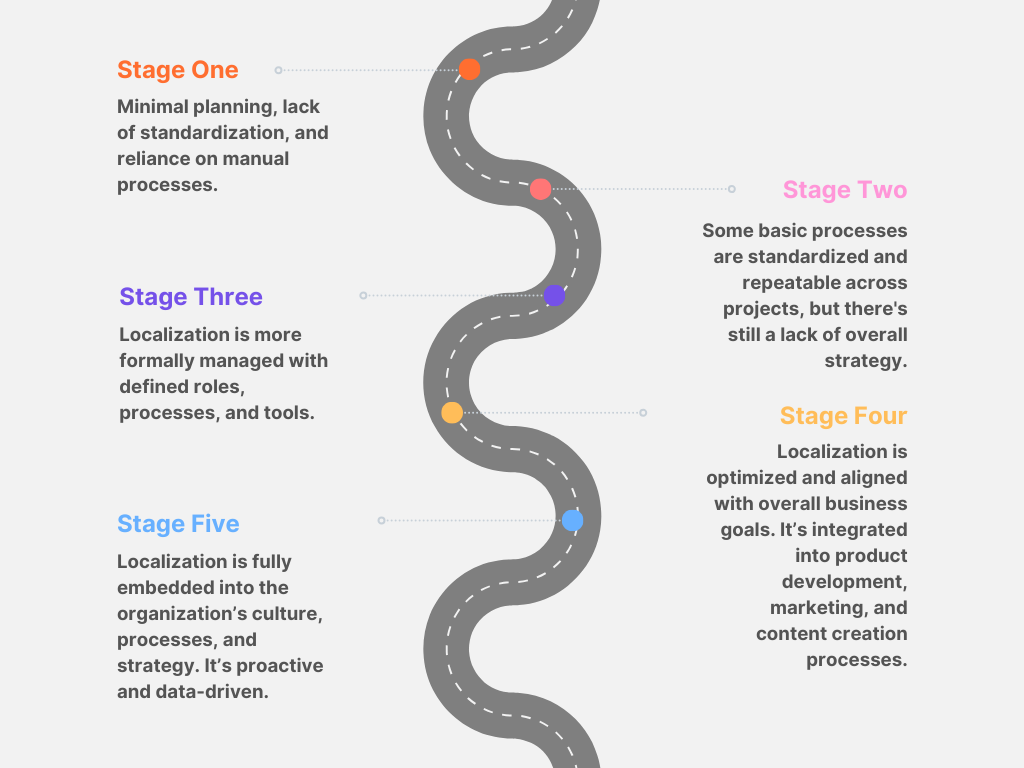
Have you heard of the term Localization Maturity Model (LMM)? Developed by CSA Research, the framework that helps organizations assess their localization processes and capabilities, guiding them in improving how they adapt content, products, and services for different languages, regions, and cultures.
If you’re a business owner, this is something worth learning more about. By measuring localization maturity, you can systematically evolve from ad-hoc or inefficient localization efforts to a fully optimized, scalable, and integrated process.
The five stages of maturity
The LMM typically defines five stages of maturity, each representing the level of sophistication and strategic integration of localization within the organization. Although different versions of the model exist, we will be discussing the most commonly used one.

1. Reactive
At the Reactive stage, companies handle localization on an as-needed basis, usually in response to immediate demands like entering new markets or addressing specific customer needs. Localization efforts at this stage are unstructured, with little planning or coordination. The focus is on short-term solutions rather than long-term process improvements, resulting in fragmented localization practices.
2. Repeatable
As businesses evolve, they enter the Repeatable stage, where some level of standardization begins to take shape. Processes are not yet fully optimized, but certain methods and tools are reused from project to project, creating more consistency.
However, localization is still seen as a separate activity, often disconnected from other business functions, leading to inefficiencies in scaling and quality control. This stage reflects efforts to streamline localization on a project-by-project basis, but organizations often face challenges in coordinating these processes across teams.
3. Managed
The Managed stage marks a shift towards more formalized localization management. Organizations introduce defined roles, workflows, and systems to oversee localization projects. Tools such as Translation Management Systems (TMS) and vendor relationships are utilized to increase efficiency and improve output quality.
Although localization efforts become more organized, they may still lack integration with the overall product development cycle. The focus is on increasing consistency and cost-effectiveness, but the processes may still operate in isolation from other critical business functions.
4. Optimized
Once localization is more integrated into the organization, the Optimized stage is reached. At this point, localization is aligned with broader business objectives, with deeper integration into product development, marketing, and content creation processes.
Automation becomes a key factor, with the use of technologies like machine translation or continuous localization workflows to streamline operations. The challenge here lies in managing complexity and scale as localization becomes a continuous, real-time process. Organizations at this stage prioritize refining efficiency, ensuring scalability, and maintaining high-quality localized content.
5. Transparent/Globalized
Finally, in the Transparent/Globalized stage, localization is fully embedded into the organization’s culture and strategies. Localization is proactive and data-driven, seamlessly integrated across all departments and aligned with global business goals.
Continuous localization happens in tandem with product development, ensuring that content is ready for international markets from the outset. At this stage, the organization is focused on fine-tuning established processes, staying innovative, and delivering a fully localized experience for users worldwide.
Why implement the Localization Maturity Model
The LMM gives you a clear roadmap for improving your localization processes. By identifying where you stand in terms of localization efficiency, you can streamline workflows, reduce costs, and enhance the quality and consistency of your localized products and services.
As you progress through the stages of the model, you can integrate localization more effectively into your product development and marketing strategies. This structured approach also helps you make informed decisions about investing in localization technology, such as automation or translation management systems.